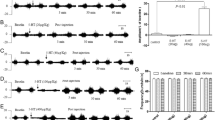Abstract
The aim of the present work was to establish whether the secretory process can be influenced by histamine H2-receptor antagonists, burimamide and metiamide. These drugs were applied intravenously and the secretion was evoked by the electrical stimulation of the chorda tympani nerve or by carbachol (i.v.). In addition to the measurements of the flow of saliva, the blood flow through the gland was measured in some experiments. Both H2-antagonists significantly reduced the rate of salivary secretion induced by the chorda tympani stimulation. The experiments with burimamide did not permit the calculation of dose-response relationship. From the experiments with metiamide the ED50 was 4.6 μmol/kg and Emax was 30% reduction of secretion. The secretory response to carbachol was not diminished by burimamide. In addition to the effect of metiamide on salivation, the reduction of the blood flow through the gland was observed: the effect on the blood flow was significantly smaller, and slower in onset, than the effect on salivation. These results support the hypothesis that H2-receptors are involved in the process of salivary secretion. Histamine effects on glandular elements seem to be more significant than its effect on the blood vessels.
Similar content being viewed by others
References
H.L. Johnson, M.A. Beaven, F. Erjavec andB.B. Brodie,Selective labelling and release of non-mast cell histamine, Life Sci.5, 115–123 (1966).
E. Werle andW. Lorenz,Speicheldrusen sekretion nach Pilocarpin, Histamin and Kininen, Arch int. Pharmacodyn. Thér.161, 477–488 (1966).
F. Erjavec, M.A. Beaven andB.B. Brodie,Uptake and release of 3 H-histamine in cat submaxillary galnd, Fedn Proc.26, 237–240 (1967).
G. Kahlson andE. Rosengren,New approaches to the physiology of histamine, Physiol. Rev.48, 155–196 (1968).
G. Kahlson andE. Rosengren,Histamine: entering physiology, Experientia28, 993–1128 (1972).
F. Erjavec, L. Stanovnik, M. Čarman-Kržan andL. Korošec,Stores of histamine and calcium in the submandibular gland of the cat during chorda tympani stimulation or infusion of pilocarpine, Iugoslav. Physiol. Pharmac. Acta10, 273–278 (1974).
A.E. Pontirolli, E. De Castro e Silva, F. Mazzoleni, M. Alberetto, G. De Pasqua, L. Stella, A. Girardi andG. Pozza,The effect of histamine and H 1-and H 2-receptors on prolactin and luteinizing hormone release in humans: Sex difference and the role of stress, J. clin. Endocr. Metab.52, 924–928 (1981).
M. Albinus andK.F. Sewing,Effect of burimamide on gastric acid secretion and gastric mucosal blood flow in cats, Agents and Actions3, 172 (1973).
L. Lundell,Acid secretion and mobilization of gastric mucosal histamine on combined cholinergic and pentagastrin stimulation, Agents and Actions4, 211–216 (1974).
J. Oscarson, R. Håkanson andG. Liedberg,The effect of secretagogues and antisecretagogues on histidine decarboxylase activity in rat gastric mucosa, Agents and Actions4, 183–184 (1974).
L. Lundell,Elucidation by H 2-receptor antagonist of the significance of mucosal histamine mobilization in exciting acid secretion. J. Physiol., Lond.244, 365–383 (1975).
H.-J. Ruoff andM. Becker,Histamine-sensitive adenylate cyclase in human gastric mucosa: Cellular localization and interaction by PGE 2,somatostatin and secretin, Agents and Actions12, 174–175 (1982).
W. Lorenz, A. Huhndt, J. Kusche, H. Barth, G. Haubensack, M. Hutrel, A. Schmal, M. Garant, A. Wächter, E. Matejka, H. Halm andE. Werle, Histamine in salivary secretion. InHistamine, pp. 187–200 (Ed.C. Maslinski). Dowden, Hutchison and Ross, Stroudsburg, Pennsylvania 1973.
F. Erjavec, M. Čarman-Kržan, R. Ozvald andM. Logonder-Mlinšek,The nature of histamine stores in submandibular gland of the cat, Iugoslav. Physiol. Pharmac. Acta10, 279–284 (1974).
W. Lorenz, St. Heitland andE. Werle,Histamin in Speicheldrüsen, Tonsillen und Thymus und adaptive Histaminbildung in der Glandula submaxillaris, Naunyn-Schmiedeberg's Arch. exp. Path. Pharmak.259, 319–328 (1968).
K. Saeki, S. Seo, M. Murakami andI. Ikehara,Effect of histamine on cyclic AMP levels in the submandibular gland, Agents and Actions11, 156–157 (1981).
N. Emmelin, Pharmacology of salivary glands. InHandbook of Physiology, Alimentary Canal, vol. 2, pp. 665–678 (Ed.C.F. Code), American Physiological Society, Washington D.C. 1967.
J.W. Black, W.A.M. Duncan, C.J. Durant, C.R. Ganelin andE.M. Parsons,Definition and antagonism of histamine H 2-receptors, Nature, Lond.236, 385–390 (1972).
R.W. Brimblecombe, W.A.M. Duncan, D.A.A. Owen andM.E. Parsons,The pharmacology of burimamide and metiamide, two histamine H 2-receptor antagonists, Fedn Proc.35, 1931–1934 (1976).
F. Erjavec,Synthesis, storage, metabolism release and function of histamine in the cat submandibular gland, Adv. Physiol. Sci.28, 97–101 (1980).
A.L. Johnson andE.G. Erdös,Release of histamine from mast cells by vasoactive peptides, Proc. Soc. exp. Biol. Med.142, 1252–1256 (1973).
F. Erjavec, F. Lembeck, T. Irman-Florjanc, G. Skofitsch, J. Donnerer, A. Saria andP. Holzer,Release of histamine by substance P, Naunyn-Schmiedebergs Arch. Exp. Path. Pharmak.317, 67–70 (1981).
J.M. Lundberg, T. Hökfelt, A. Änggård andJ. Fahrenkrug, Functional implications of coexistence of peptides and classical transmitters: Studies on exocrine glands. InAdvances in Pharmacology and Therapeutics II, pp. 177–187 (EdsH. Yosuida, Y. Hagihara andS. Ebashi). Pergamon, Oxford, New York, Toronto, Sydney, Paris, Frankfurt 1982.
T. Shimizu andN. Taira,Pharmacological analysis of salivary and blood flow responses to histamine of the submandibular gland of the dog, Br. J. Pharmac. Chemother.68, 651–661 (1980).
Z.S. Ercan andR.K. Tuerker,Alteration of histamine receptor agonists of the release of adrenergic transmitter in the isolated perfused rabbit kidney, Archs int. Pharmacodyn. Thér.249, 203–212 (1981).
Author information
Authors and Affiliations
Rights and permissions
About this article
Cite this article
Stanovnik, L., Erjavec, F. The inhibition of salivary secretion by histamine H2-antagonists—a study on the cat submandibular gland. Agents and Actions 13, 196–199 (1983). https://doi.org/10.1007/BF01967330
Issue Date:
DOI: https://doi.org/10.1007/BF01967330




